Table Of Contents
Strong and toned arms are always in trend, whether you’re gearing up for beach season or simply want to feel confident in any outfit. But it is not just about rock-solid biceps; your triceps also need some love and training.
But fear not! Your quest for stronger, more defined arms doesn’t have to be confined to mundane cable press-downs or repetitive dumbbell routines. There are a vast number of movements that are far more effective and fun to perform.
If you want thick and chiseled triceps like a powerlifter, I’ve created a workout plan to help you see a new you in the mirror. Gear up, and let’s roll!
Also, read – Rear Delt Fly 101: Set Your Deltoids on Fire
Why Strong Triceps Matter for Defined Arms
While biceps often steal the spotlight, your triceps actually make up about two-thirds of your upper arm mass. Developing strong triceps not only creates balanced, proportional arms but also enhances your pushing strength for everyday activities and other exercises. Whether you’re pushing a heavy door, performing a push-up, or bench pressing, your triceps are key players in these movements.
Tricep training improves joint stability around the elbow and shoulder, potentially reducing injury risk during other activities. Plus, well-developed triceps give your arms that coveted horseshoe shape when viewed from behind, adding definition that completes the look of toned, sculpted arms.
Essential Preparation for Effective Tricep Workouts
Growing powerful triceps is not only about the workout; you should also focus on the preparation to enter the game warmed up and ready to rock those arms. Here are some key tips for big triceps to help you be primed for success:
Proper Warm-Up Techniques
Working out without warming up is less effective and potentially dangerous. Always begin your fitness routine with light cardio, such as walking or cycling. This will get your blood flowing and your muscles warmed up. Then, perform dynamic stretching targeting the arms and shoulders to prevent injury. If possible, consider light movements that mimic the exercises you will perform.
Selecting Appropriate Weight for Your Level
Don’t aim for the biggest weight if you’re a newbie; start slow and gentle by choosing dumbbells that challenge your muscles, but don’t compromise your form and put you at risk of injury. Gradually increase the weight as you become stronger and more confident in your arms.
Form and Technique Fundamentals
Bring your technique to perfection, minimize the risk of injury, and ensure maximum effectiveness of the exercises. Consult with a professional or watch YouTube videos to ensure you perform each move correctly. Pay attention to your posture, range of motion, and muscle engagement.
Hydration Requirements
Drink plenty of water before, during, and after your workout. Stay hydrated to the max to maintain optimal performance and prevent dehydration.
Developing Mind-Muscle Connection
Visualize each muscle contraction and extension during the workout to build a solid mind-body connection. This mental connection can enhance muscle activation and maximize your tricep gains.
Listening to Your Body’s Signals
Be gentle to yourself and react to any pain or discomfort right away by stopping the workout. Never push through pain, as it can lead to serious injury; safety first!
Also, read – How to Get Rid of Muffin Top
Understanding Tricep Anatomy for Better Results
Understanding the anatomy of your triceps is key to effectively targeting and strengthening these muscles. The triceps brachii, commonly called the triceps, consists of the following heads:
- Long Head. The largest and most visible head of the triceps, the long head, is responsible for the overall mass and shape of the muscle. It runs along the back of the arm and is primarily engaged during shoulder extension exercises.
- Lateral Head. Situated on the outer side of the arm, this head contributes to the width and definition of the triceps. It is activated during exercises that require elbow extensions, such as dumbbell kickbacks and triceps extensions.
- Medial Head. Located beneath the long head, the medial head adds depth to the triceps and supports elbow extension movements. It is engaged during various triceps exercises, including close-grip presses and dips.
Each head responds differently to various exercises, so a complete tricep workout routine should include movements that target all three heads for balanced development.
Dumbbell Weight Standards for Tricep Training
Working out with dumbbells is a science of its own; you should find a perfect balance between the weight, the form, and the number of repetitions. If you use dumbbells that are too light or heavy for you, maintain the wrong technique, or exercise too much or too little, you risk injuring yourself or not seeing results.
Let’s walk through everything you need to know about how effectively you can work your triceps with dumbbells.
Men’s Recommended Weights by Experience Level
Before diving into your triceps workout, you must understand how much weight you should be lifting to get bigger triceps.
Please note! Dumbbell weights are indicated for one dumbbell.
Male Tricep Curls Dumbbell Standards (lb/kg)
| Strength Level | Weight |
| Beginner | 14 lb/6 kg |
| Novice | 29 lb/13 kg |
| Intermediate | 52 lb/23 kg |
| Advanced | 80 lb/36 kg |
| Elite | 113 lb/51 kg |
Women’s Recommended Weights by Experience Level
Female Dumbbell Curl Standards (lb/kg)
| Strength Level | Weight |
| Beginner | 8 lb/3 kg |
| Novice | 17 lb/8 kg |
| Intermediate | 30 lb/14 kg |
| Advanced | 47 lb/21 kg |
| Elite | 67 lb/31 kg |
Remember that these are general guidelines and your individual strength level may vary. Always start with a weight you can control with proper form and gradually increase as you build strength.
Also, read – Chest Workouts With Dumbbells: Sculpt Your Upper Body
Beginner-Friendly Tricep Dumbbell Exercises
Whether you’re a newbie or a gym-goer looking to jazz up your routine, working your triceps with dumbbells offers a fantastic way to build strength and definition in your arms. From beginners to pros, you can incorporate a wide range of dumbbell tricep exercises at home or at the gym, so let’s roll!
Lying Dumbbell Tricep Extension

Difficulty: 2/10
- Lie on a flat bench holding dumbbells, with your arms extended overhead.
- Keep your elbows close to your head as you lower the dumbbells towards your shoulders, feeling a stretch in your triceps.
- Press the dumbbells back up to the starting position, focusing on squeezing your triceps at the top of the movement.
Dumbbell French Press
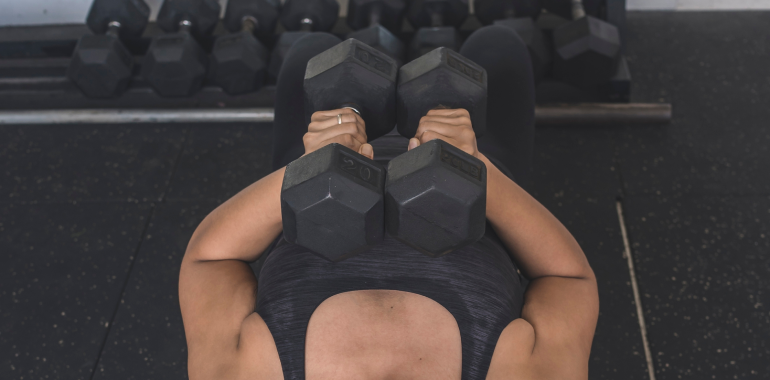
Difficulty: 3/10
- Sit on a bench with back support. Hold a dumbbell with both hands overhead.
- Lower the dumbbell behind your head and keep your elbows close to your ears.
- Extend your arms, press the dumbbell back up, and focus on engaging your triceps.
Close Grip DB Press

Difficulty: 4/10
- Lie on a flat bench. Hold dumbbells in your hands, palms facing inward.
- Keep your elbows close to your body as you lower the dumbbells towards your chest.
- Press the dumbbells back up, focusing on squeezing your chest and triceps.
- Repeat for the desired number of repetitions.
Two Arm Seated Dumbbell Extension
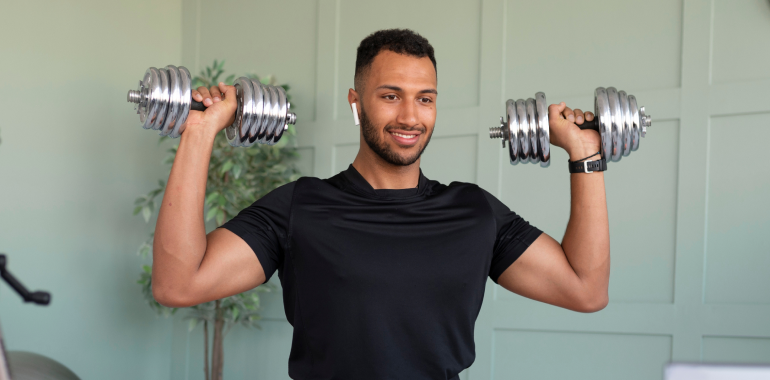
Difficulty: 4/10
- Sit on a bench with back support. Hold a dumbbell with both hands overhead.
- Lower the dumbbell behind your head and keep your elbows close to your ears.
- Extend your arms, press the dumbbell back up, and focus on engaging your triceps.
Intermediate Tricep and Chest Combination Exercises
Do you crave a bit of challenge and want to enhance your routine? Here are some more advanced but still manageable exercises for intermediate lifters to try. These tricep exercises dumbbells at home can also be performed at the gym for added variety.
Dumbbell JM Press

Difficulty: 5/10
- Lie on a flat bench. Hold dumbbells in your hands, palms facing each other.
- Lower the dumbbells towards your chest while keeping your elbows tucked in.
- Press the dumbbells up and towards your feet, extending your arms overhead.
- Reverse the movement to return to the starting position, focusing on engaging your triceps and chest.
Neutral Grip DB Bench Press
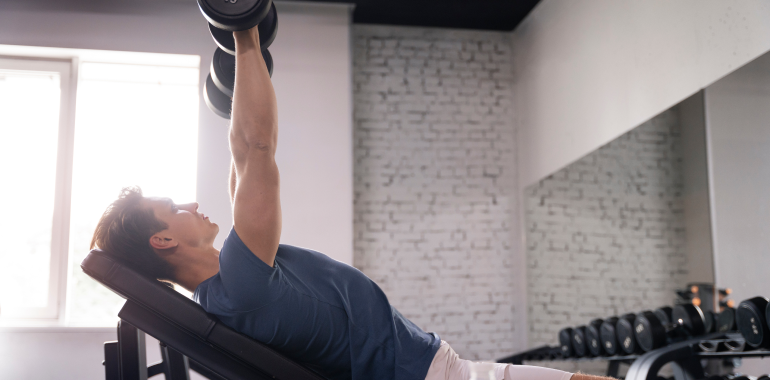
Difficulty: 8/10
- You should start by lying on a flat bench, holding a dumbbell in each hand and palms facing each other.
- Press the dumbbells up towards the ceiling while keeping your elbows slightly bent.
- Lower the dumbbells back down to chest level.
Tate Press Exercise
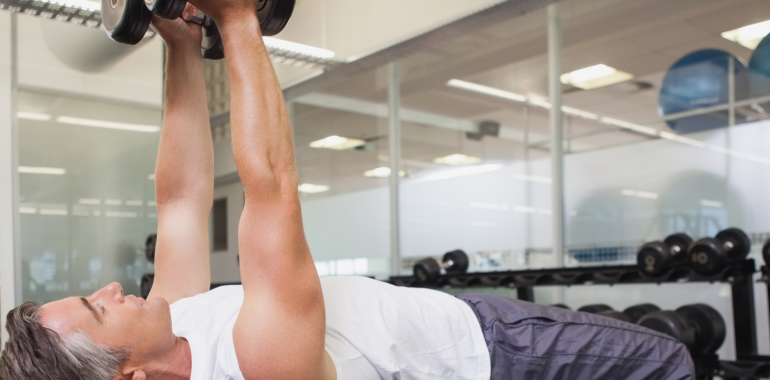
Difficulty: 8/10
- Lie on a flat bench for extra support and hold a dumbbell in each hand. Your palms should face each other.
- Bring the dumbbells together directly above your chest, elbows bent at a 90-degree angle.
- Lower the dumbbells towards your chest while keeping your elbows close to your body.
- Press the dumbbells back up to the starting position, focusing on engaging your triceps and chest.
Advanced Compound Tricep Exercises
For gym enthusiasts looking to improve their tricep workouts, compound exercises can provide a challenging and effective way to make triceps bigger and stronger. These movements engage multiple muscle groups while placing significant focus on your triceps.
Here are some seated and standing tricep dumbbell exercises using dumbbells tailored for advanced lifters:
Single Arm Dumbbell Extension

Difficulty: 7/10
- Stand or sit on a bench with back support, holding a dumbbell in one hand overhead.
- Lower the dumbbell behind your head while keeping your elbow close to your ear.
- Extend your arm to press the dumbbell back up. Make sure to engage your triceps.
Incline Dumbbell Overhead Extensions
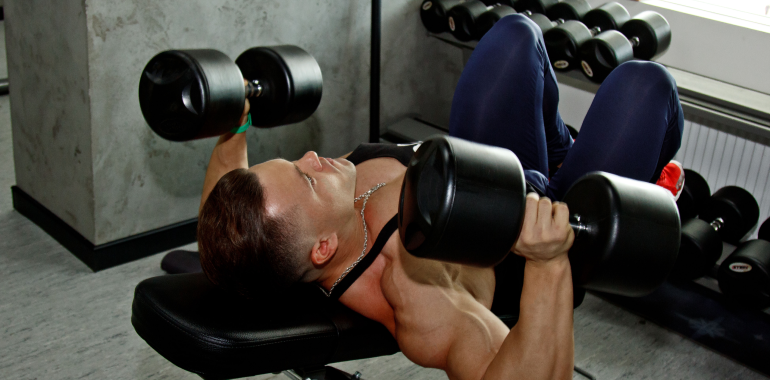
Difficulty: 8/10
- Sit on an incline bench with back support, holding a dumbbell with both hands overhead.
- Lower the dumbbell behind your head, and always keep your elbows close to your ears.
- Extend your arm to press the dumbbell back up. Make sure to engage your triceps.
Single Arm Tricep Kickback
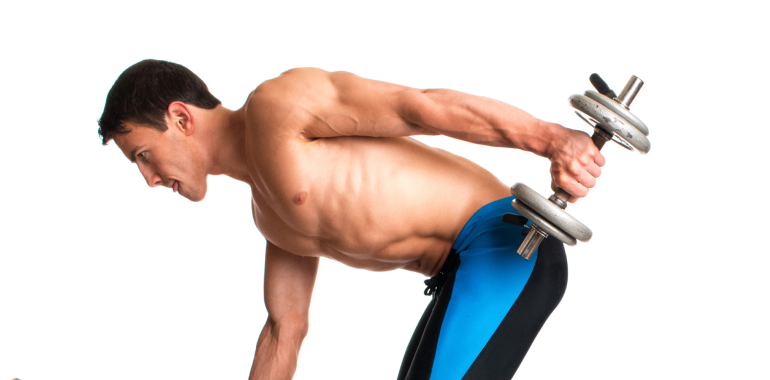
Difficulty: 7/10
- Hold a dumbbell in one hand and hinge at the waist, keeping your back flat.
- Extend your arm behind you, squeezing your triceps.
- Lower the dumbbell back to the starting position with control.
- Repeat on each arm.
High Incline Dumbbell Press
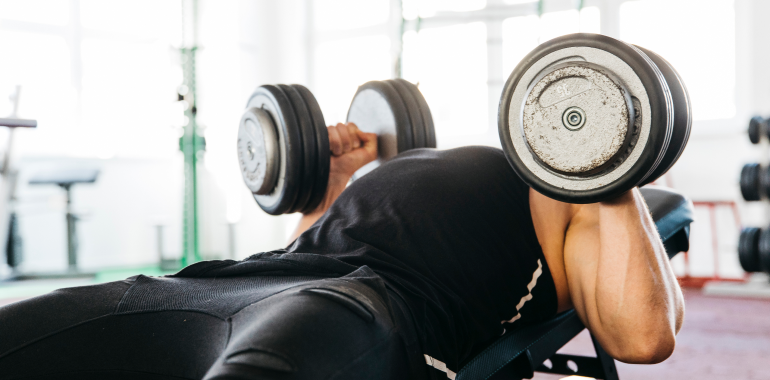
Difficulty: 8/10
- Lie on an incline bench with an upright angle.
- Hold a dumbbell in each hand at shoulder height.
- Press the dumbbells upwards toward the ceiling while keeping your elbows slightly bent.
- Lower the dumbbells back down to reach your shoulders with control.
Incline Dumbbell Kickbacks

Difficulty: 8/10
- Sit on an incline bench with back support, holding a dumbbell in each hand.
- Lean forward and extend your arms straight behind you, squeezing your triceps at the movement’s top.
- Slowly lower the dumbbells back to the starting position with control.
- Repeat for the desired number of repetitions.
At Home Tricep Dumbbell Exercises
What if you don’t have time to hit the gym? Does that mean there’s no way to sculpt your triceps? Worry not. If you have a pair of dumbbells at home, your living room can become your gym and help you achieve mind-blowing results without fancy gym equipment. These at home tricep dumbbell exercises are perfect for when time is limited or you prefer working out in the comfort of your own space.
Overhead Dumbbell Tricep Extension
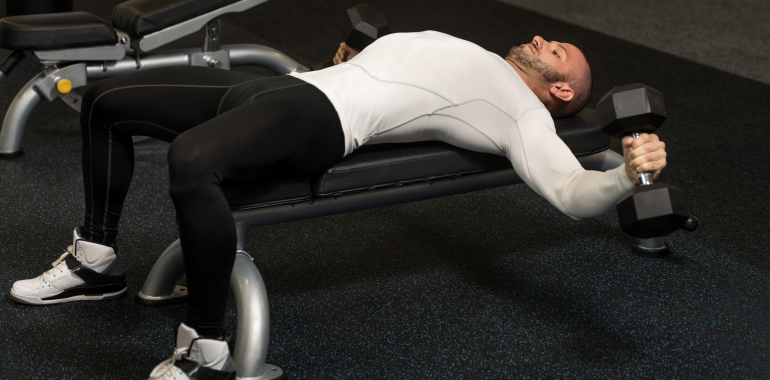
Difficulty: 6/10
- Stand or sit on a bench with back support, holding a dumbbell with both hands overhead.
- Bend your elbows to lower the dumbbell behind your head.
- Press the dumbbell back up. Focus on engaging your triceps.
One Arm Seated Dumbbell Extension
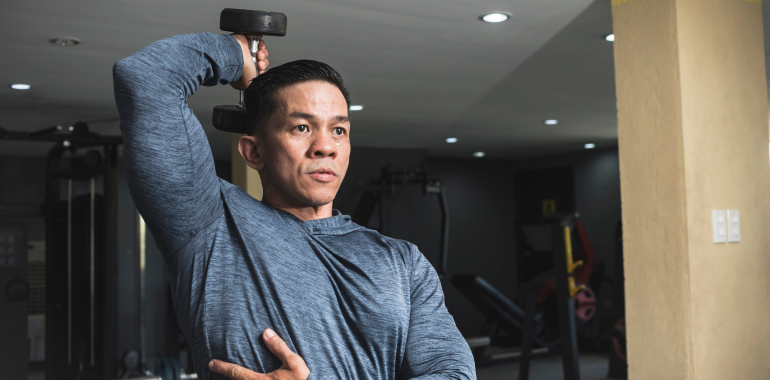
Difficulty: 7/10
- Sit on a bench with back support, holding a dumbbell with one hand overhead.
- Lower the dumbbell behind your head by bending your elbow while keeping it close to your ear.
- Extend your arm to press the dumbbell back up to the starting position, focusing on engaging your triceps.
Lying Dumbbell Tricep Extension

Difficulty: 6/10
- Lie flat on your back on a bench or mat, holding a dumbbell in each hand above your chest.
- Bend your elbows to lower the dumbbells towards your temples while keeping them close to your head.
- Extend your arms to press the dumbbells back up to the starting position, focusing on engaging your triceps.
Single Arm DB Tricep Extension
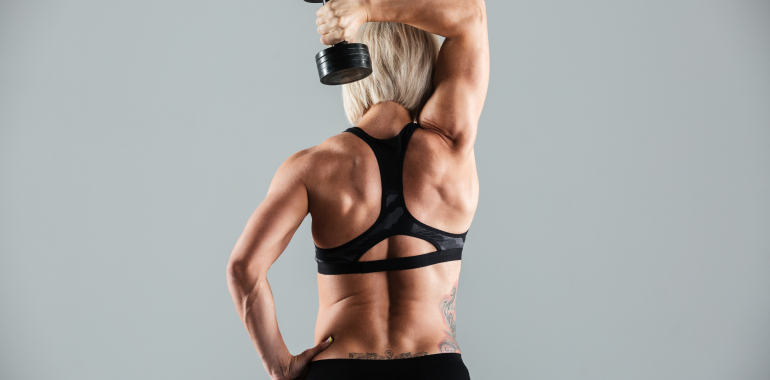
Difficulty: 7/10
- Stand tall or sit on a bench with back support, holding a dumbbell in one hand with your arm extended overhead.
- Lower the dumbbell behind your head by bending your elbow while keeping it close to your head.
- Extend your arm to press the dumbbell back up to the starting position, focusing on engaging your triceps.
One Arm DB Press
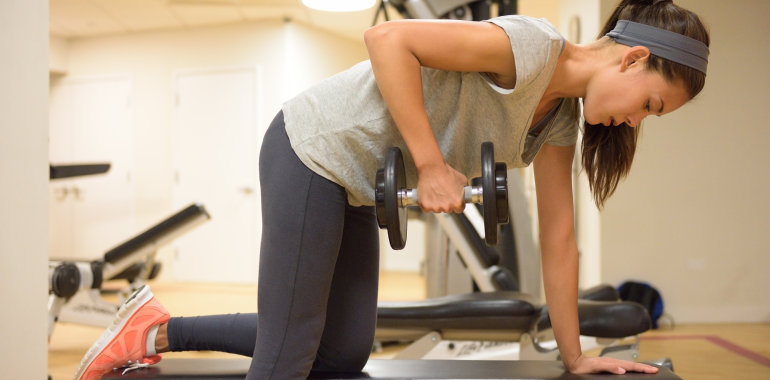
Difficulty: 6/10
- Sit on a bench with back support, holding a dumbbell in one hand at shoulder height.
- Press the dumbbell overhead while keeping your elbow slightly bent.
- Lower the dumbbell back down to shoulder height and repeat for the desired number of repetitions on each arm.
Tricep Pushdowns with Dumbbells
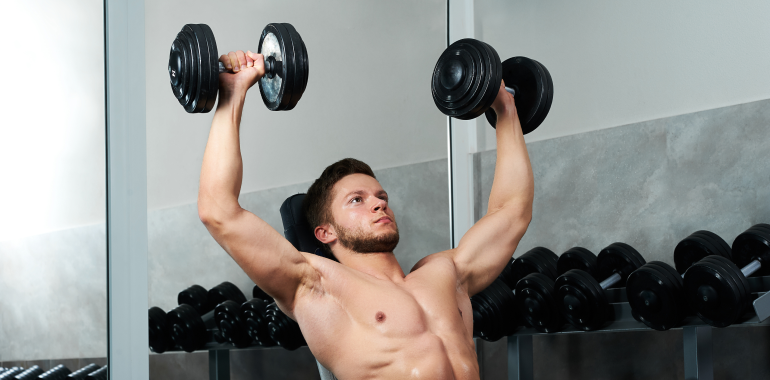
Difficulty: 3/10
- Stand upright with a dumbbell in each hand, palms facing inward, and elbows tucked into your sides.
- Extend your arms downward, keeping your elbows stationary until fully extended.
- Squeeze your triceps at the bottom of the movement, then slowly return to the starting position.
- Focus on keeping your upper arms still throughout the exercise to isolate the triceps.
Target-Specific Tricep Exercises
To fully develop your triceps, it’s important to target each of the three heads with specific exercises. Here’s how to focus on each area for complete tricep development:
Long Head Focused Movements
The long head of the triceps is best targeted with overhead movements that place the arm in a stretched position. Exercises like overhead dumbbell extensions and French presses are particularly effective for this head. When performing these movements, ensure your elbows stay close to your head and focus on a full range of motion to maximize long head activation.
Lateral Head Development Exercises
To target the lateral head, which gives your triceps width, focus on exercises where your arms are positioned alongside your body. Tricep pushdowns, kickbacks, and close-grip presses are excellent choices. When performing these exercises, keep your elbows tucked in and focus on squeezing the triceps at full extension.
Medial Head Strengthening Techniques
The medial head is engaged in almost all tricep exercises but can be more specifically targeted with exercises that involve extension against resistance with the arm in various positions. Diamond push-ups, dumbbell extensions, and reverse grip tricep pushdowns are effective choices. For these exercises, focus on complete extension of the elbow and controlled movement to maximize medial head activation.
Also, read – What Foods Can Make Your Butt Bigger?
Troubleshooting Tricep Growth Issues
You’ve been doing all these exercises daily, sticking to a regular workout routine, but your triceps aren’t growing as expected? We’re all unique, and predicting how your body will react to a new workout routine is impossible. A couple of factors can contribute to your triceps not growing and you not experiencing all the benefits of strong triceps.
Intensity and Progressive Overload
If you’re not challenging your triceps with enough weight, reps, or sets, they may not respond with significant growth. Consider increasing the workload gradually to ensure progressive overload. This might mean adding more weight, performing more repetitions, or reducing rest periods between sets.
Exercise Selection for Complete Development
Aim your tricep workouts to hit all heads of the triceps effectively. Remember to make your workout routine versatile and select movements targeting the long, lateral, and medial heads to promote balanced development. Include a mix of compound movements (like close-grip bench presses) and isolation exercises (like tricep extensions).
Recovery Strategies for Optimal Growth
Recovery is the key to progress. Let your muscles rest and recover between sessions; they won’t have time to repair and grow stronger. Ensure you get enough sleep, manage stress levels, and incorporate rest days into your workout routine. Consider techniques like foam rolling, gentle stretching, and adequate hydration to enhance recovery.
Nutrition Requirements for Muscle Building
Working out without proper nutrition is a waste of time. You should nourish your body with enough calories, protein, and other essential nutrients for optimal performance and muscle growth. If your triceps aren’t growing, consider your diet and incorporate changes where necessary. Make sure your diet supports your fitness goals by including lean proteins, healthy fats, complex carbohydrates, and plenty of vitamins and minerals.
Finding Your Optimal Training Volume
Both over- and undertraining can affect muscle growth. Overtraining occurs when you do too much, leading to fatigue, injury, and diminished performance. On the other hand, undertraining involves not providing enough stimulus for growth. Find the right balance by listening to your body, allowing for adequate recovery, and adjusting your training volume accordingly.
Also, read – Surprising Benefits of Sauna After Workout
Creating Your Custom Tricep Workout Plan
Designing an effective tricep workout routine requires consideration of your fitness level, goals, and available equipment. Here’s how to create a personalized tricep training plan using dumbbells:
For beginners, start with 2-3 basic exercises like dumbbell kickbacks, overhead extensions, and close-grip pushups. Perform 2-3 sets of 10-12 repetitions with moderate weight, focusing on proper form. Train triceps 1-2 times per week, allowing at least 48 hours between sessions for recovery.
Intermediate lifters should include 3-4 exercises per session, combining compound movements like close-grip bench press with isolation exercises like skull crushers. Perform 3-4 sets of 8-12 repetitions, gradually increasing weight. Train triceps 2-3 times weekly, either in dedicated arm sessions or as part of push-day workouts.
Advanced lifters can incorporate 4-5 exercises per session, including advanced variations like weighted dips and decline close-grip press. Experiment with techniques like drop sets, supersets, and rest-pause training to increase intensity. Perform 4-5 sets of 6-12 repetitions depending on the exercise, and consider splitting tricep training across multiple weekly sessions for maximum development.
Regardless of your level, regularly assess your progress and adjust your program every 4-6 weeks to prevent plateaus. Remember that consistency, proper nutrition, and adequate recovery are just as important as the exercises themselves for achieving impressive tricep development.
Wrapping Up
This journey is not just about stronger triceps; it’s about stronger willpower, dedication, and mind-body connection. You’re laying a foundation for a more mindful, healthy, and strong future by showing up to your workouts regularly. The dumbbell tricep exercises at home shared in this guide provide everything you need to build impressive arms without expensive equipment.
If you are discouraged, remember that progress is not always linear, and everyone’s fitness journey is unique. Celebrate your victories, no matter how small, and stay focused on the positive changes you make for your health and well-being. With the variety of tricep exercises dumbbells at home options available, you can continuously challenge your muscles in new ways.
So, keep pushing yourself, stay consistent, and, most importantly, enjoy the process! Your future self with well-defined, powerful arms will thank you for the effort you’re putting in today with these at home tricep dumbbell exercises.
Chris is a certified exercise physiologist with over 13 years of experience in fitness and wellness. With a Master of Science in Exercise and Wellness, Chris has been a educating the public as a writer, editor, and trainer. He is passionate about creating evidence-based content in an engaging way to make learning fun.









